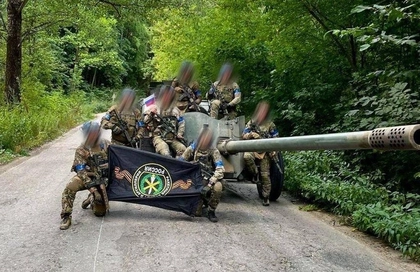On the 23rd anniversary of Ukraine’s 1991 declaration of independence, in August 2014, uniformed Russian troops invaded in force, crossing Ukraine’s eastern border to prevent the defeat of Kremlin-sponsored “separatists” by Kyiv’s forces.
Ukrainian and even some international media identified and watched trucks carrying hundreds of paratroopers from Russia’s elite 76th Airborne Division rumble across the international frontier into Ukraine’s Donetsk region. Dark-green-painted tanks and infantry fighting vehicles marked with white invasion stripes led the columns.
JOIN US ON TELEGRAM
Follow our coverage of the war on the @Kyivpost_official.
Independent analysts later estimated that Russia sent around 10,000 heavily armed troops and advisors into Ukraine. That Russian invasion – albeit directly violating two treaties signed by Moscow with Kyiv to respect Ukraine’s borders – ground down Ukraine’s poorly equipped army.


Nukes Nukes Nukes! Kremlin’s Hawk Medvedev Extensive 2024 Use of Nuclear Bluff
Repeatedly, when Ukrainian defenses coalesced and separatist attacks stalled, the Kremlin committed more troops to break Kyiv’s forces. An epic siege of Donetsk airport, where Ukrainian paratroopers, mechanized infantrymen and special forces troops held out for nearly four months against near-daily assault, ended after Moscow sent elite Marine regiments from Murmansk to storm terminals or flatten them with artillery.
Moscow’s conventional arms, main force assault backed by massed artillery, and Grad rocket launchers firing from the Russian side of the border halted Armed Forces of Ukraine (AFU) advances against embattled local pro-Russia militia that had been steadily losing ground to Ukrainian forces across the Donbas region.
By February 2015, a desperate Ukraine, at the time receiving only limited supplies of light weapons from some Western states, and facing a mobilized Russian military, signed agreements accepting the Kremlin’s de facto control and military occupation of portions of the Luhansk and Donetsk regions, a territory roughly the size of Belgium.
During the incursion, Kremlin spokesmen flatly denied Russia had invaded Ukraine. According to the official Moscow line at the time, Russian troops killed or wounded in Ukraine, and Russian army equipment captured by the AFU, were there because soldiers conducting training inside Russia had gotten lost.
The flood of images and independent accounts attesting to the largest invasion of one European state by another since the Balkan wars of the 1990s, was, according to that narrative, fake news manufactured by an illegitimate government in Kyiv that had taken control of Ukraine’s government in a coup. In fact, Moscow claimed, the Ukrainian army was fighting oppressed Donbas coal miners and shop owners who had found and armed themselves with hundreds of tanks and artillery pieces.
Thousands of Ukrainian civilian volunteers taking up arms and heading east to fight the Russian invaders were, per Russian state media reports, right-wing militants motivated by Nazi ideology and armed and paid by NATO nation spy agencies.

With the hindsight of Russia’s even more massive, second invasion of Ukraine eight years later in 2022, the Western response to the Kremlin’s assault on Ukrainian sovereignty on that country’s national independence day, in 2014, seems anemic and ill-judged.
The US from 2014-2021 sent Ukraine about $1.5 billion in military-type assistance, practically none of it in actual weaponry. This was a drop in the bucket compared to the $75+ billion – some of it in top-line US arms like the Patriot anti-aircraft system and the HIMARS precision-guided rocket launcher – dispatched or promised from 2022-24.
In 2009, US decision-markers, led by President Barack Obama and Secretary of State Hillary Clinton, unveiled a “Russian Reset” policy aimed at containing Russian aggression by improving economic relations and reducing confrontation.
Chancellor Angela Merkel of Germany over the latter half of the 2010s both pushed policies of closer economic relations with Russia and responded to the Russian invasion of Ukraine by tacitly accepting the Kremlin land grab while criticizing it mildly from time to time. German military support to Ukraine, as with practically all other European states, was negligible.

But Russia’s first invasion of Ukraine, on Ukraine’s 23rd birthday, also marked the start of the rebirth of the AFU, whose officers from the days of August 2014 – in sharp contrast to military men in Europe and the US – started planning and training for further combat against the Russian army, with the assumption the Ukrainian army could hold its own. Slowly, as frontline lieutenants and privates fighting the Russian army in 2014-15 rose in the ranks, AFU unit tactical competence improved.
Along a “ceasefire” line that frequently saw infantry assaults and artillery exchanges, tens of thousands of Ukrainian troops rotated to and from the front, gaining irreplaceable combat experience and honing fighting skills. For professional AFU cadre, following Russia’s first invasion, the assumption was war was coming, that Russian would not stop, and that the AFU needed to prepare seriously.
When Russia invaded Ukraine a second time, in 2022, it encountered an agile, motivated opponent that sometimes seemed to know Russian army weaknesses as well as the Russian soldiers themselves, and that frequently kept on fighting for weeks despite being outgunned, or surrounded, or both. Russian missile and air strikes pounded empty Ukrainian airfields. Russian helicopter assaults found missile gunners waiting for them. Tank columns that by the Kremlin plan should have taken the capital Kyiv in a matter of hours stalled for weeks because the roads went through low terrain and the Ukrainians, it turned out, had come up with a plan for flooding them.
In that sense, hard-core and effective Ukrainian military resistance to Russia’s second invasion was a direct and probably the most important outcome, from Russia’s first open, armed invasion of Ukraine, launched on Ukraine’s 23rd birthday.
You can also highlight the text and press Ctrl + Enter






